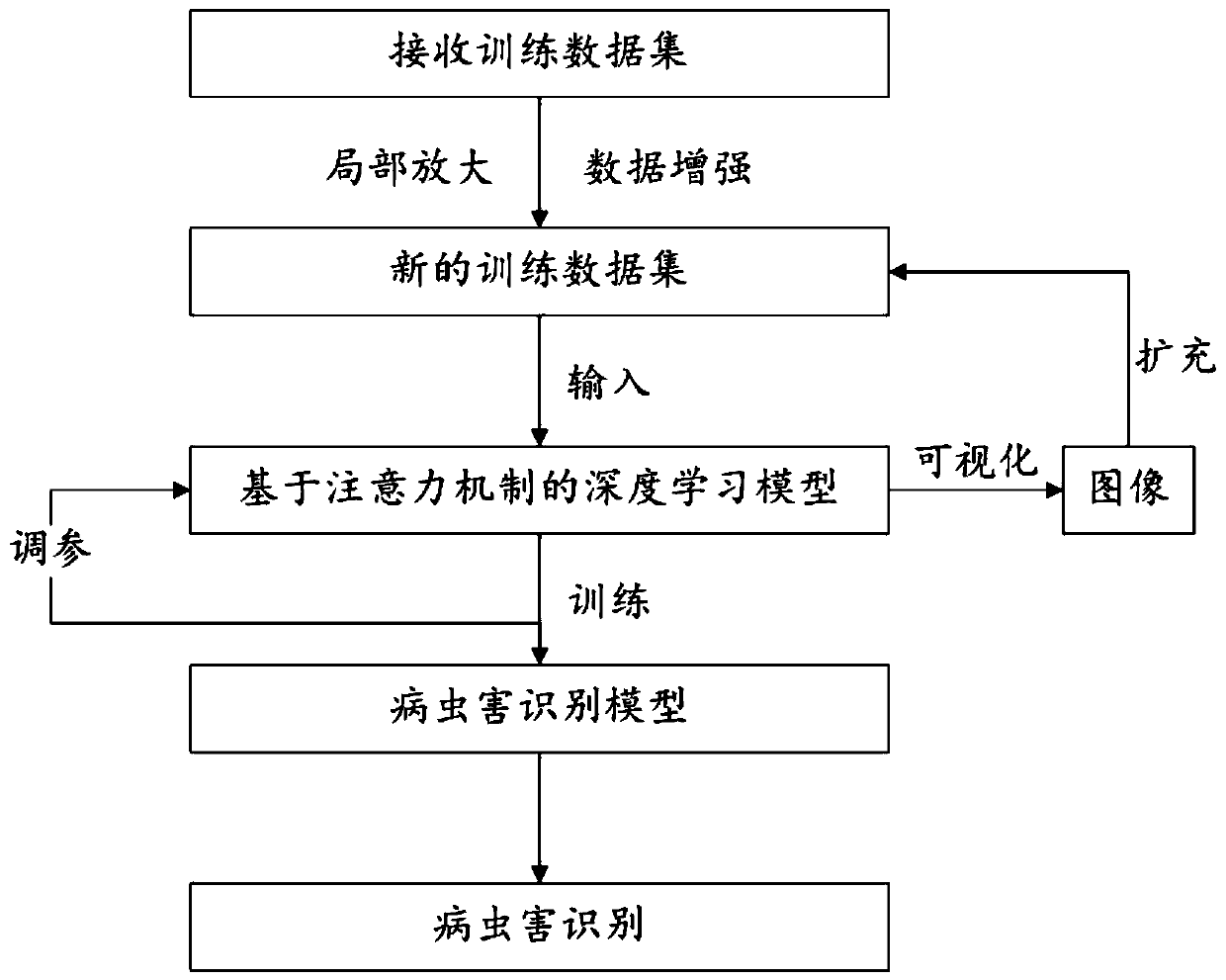Plant disease and insect pest identification method and system based on deep learning
A technology of deep learning and recognition methods, applied in the field of computer vision, can solve problems such as small amount of data, failure to meet model training requirements, difficulty in model training, etc., and achieve the effect of improving accuracy
- Summary
- Abstract
- Description
- Claims
- Application Information
AI Technical Summary
Problems solved by technology
Method used
Image
Examples
Embodiment 1
[0030] This embodiment discloses a method for identifying plant diseases and insect pests based on deep learning, comprising the following steps:
[0031] Step 1: Receive image data of various types of plant diseases and insect pests, and each type contains multiple images.
[0032] Step 2: Carry out data enhancement processing to the image, obtain the partial image of plant diseases and insect pests based on the above image, and perform random image preprocessing. The image preprocessing method includes: image transformation (such as zooming, cropping, rotating and flipping images, etc.), and Image quality adjustment (such as brightness, contrast adjustment and blur processing, etc.).
[0033] Described step 2 specifically comprises:
[0034] Step 2.1: All original image data are firstly partially enlarged for the diseased part.
[0035] Step 2.2: Randomly tilt, distort, randomly cut, crop, mirror flip, Gaussian distortion, adjust brightness, adjust contrast, rotate 90 degr...
Embodiment 2
[0049] The purpose of this embodiment is to provide a plant disease and pest identification system based on deep learning.
[0050] In order to achieve the above object, the present embodiment provides a plant disease and pest identification system based on deep learning, including:
[0051] The training data acquisition module receives the original training image, and the original training image includes image data of various plant diseases and insect pests;
[0052] The training data preprocessing module receives the image preprocessing method selected by the user for the training image, and performs image preprocessing;
[0053] The training data expansion module inputs the image output of the training data preprocessing module into a pre-built deep learning model based on the attention mechanism according to the pest category, and the deep learning model includes a sequentially connected convolution layer, a residual attention mechanism model and Fully connected layer; visu...
Embodiment 3
[0057] The purpose of this embodiment is to provide an electronic device.
[0058] An electronic device, comprising a memory, a processor, and a computer program stored on the memory and operable on the processor, when the processor executes the program, the following steps are implemented, including:
[0059] (1) receiving the original training image, which includes various image data of plant diseases and insect pests in the original training image;
[0060] (2) Receive the image preprocessing method selected by the user for the training image, and perform image preprocessing;
[0061] (3) input the pre-processed image into the pre-built deep learning model based on the attention mechanism by the pest category, and the deep learning model includes successively connected convolutional layers, residual attention mechanism models and fully connected layers; The output of the residual attention mechanism model is visualized as a new training image, and returns to step (2) until...
PUM
 Login to View More
Login to View More Abstract
Description
Claims
Application Information
 Login to View More
Login to View More - R&D
- Intellectual Property
- Life Sciences
- Materials
- Tech Scout
- Unparalleled Data Quality
- Higher Quality Content
- 60% Fewer Hallucinations
Browse by: Latest US Patents, China's latest patents, Technical Efficacy Thesaurus, Application Domain, Technology Topic, Popular Technical Reports.
© 2025 PatSnap. All rights reserved.Legal|Privacy policy|Modern Slavery Act Transparency Statement|Sitemap|About US| Contact US: help@patsnap.com


